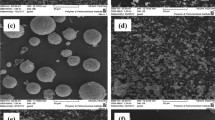Abstract
A cracking catalyst designatedSRNY was manufactured from a commercialSRNY molecular sieve (M.S.). The support consisted of kaolin, clay and SiO2. The coking behaviour of theSRNY M.S., the support and the catalyst were examined with light diesel oil (LDO) as feedstock in a microreactor. The physico-chemical properties of both fresh and aged samples, subjected to or not subjected to the cracking reaction ofLDO, were sequentially characterized by means of pore structure determination and thermal analysis. The pore structure included the specific surface area and the pore volume or porosity. Thermal analysis methods used included TG and DSC.
The results indicated that all coked samples exhibited obvious changes in surface pore structure and acidity in comparison with non-coked samples. Their specific surface area and acid amount decreased with increase in the coke content of the samples. The apparent activation energy data obtained from decoking samples in an air flow, using the temperature-programmed oxidation (TPO) method, showed that the kinetic parameters of theSRNY M.S. differed from those of theSRNY catalyst and its support.
Zusammenfassung
Aus einem handelsüblichenSRNY Molekularsieb (M.S.) wurde ein mitSRNY benannter Krack-Katalysator hergestellt. Das Trägermaterial besteht aus Kaolin, Ton und SiO2. Mit leichtem Dieselöl (LDO) als Eintrag in einem Mikroreaktor wurde das Verkokungsverhalten desSRNY M.S., des Trägermateriales und des Katalysators untersucht. Mittels Porenstrukturbestimmung und Thermoanalyse wurden die physikalisch-chemischen Eigenschaften von frischen und gealterten Proben in und außer der Krackreaktion vonLDO charakterisiert. Die Porenstruktur umfaßt die spezifische Oberfläche und das Porenvolumen der Porösität. Thermoanalyse bedeutete in diesem Falle TG und DSC.
Die Ergebnisse zeigten, daß alle verkokten Proben im Vergleich zu nicht verkokten Proben eindeutige Änderungen der Oberflächenporenstruktur und Azidität aufwiesen. Spezifische Oberfläche und Säuregehalt sinken mit steigendem Koksgehalt in den Proben. Die scheinbare Aktivierungsenergie, die unter Einsatz einer temperaturprogrammierten Oxidationsmethode (TPO) an Entkohlungsproben in einem Luftstrom erhalten wurde, zeigte, daß sich die kinetischen Parameter desSRNY M.S. von denen desSRNY-Katalysators und des Trägermateriales unterscheiden.
Similar content being viewed by others
References
R. Hughes, Deactivation of Catalysts, Academic Press (London) 1984, p. 13, p. 112.
E. E. Petersen and A. T. Bell, Catalyst Deactivation, Marcel Dekker, New York and Basel 1987, p. 39, p. 235.
J. B. Butt and E. E. Petersen, Activation, Deactivation, and Poisoning of Catalysts, Academic Press, Harcourt Brace Jovanovich, Publishers, San Diego, New York, Berkeley, Boston, London, Sydney, Tokyo, Toronto 1988, p. 63.
Li Chenglie, Li Xianjun and Zhang Guotai, Catalyst Deactivation (in Chinese), Chemical Industry Press, 1989, p. 166.
Zhang Dichang and Da Zhijian, Thermochim. Acta, 233 (1994) 87.
H. E. Kissinger, Analytical Chemistry, 29 (1957) 1072.
E. Louis, C. Garcia-Cordorilla, J. Thermal Anal., 29 (1984) 1139.
E. Ingier-Stocka, J. Thermal Anal., 36 (1990) 2139.
Author information
Authors and Affiliations
Rights and permissions
About this article
Cite this article
Zhang, D. TG and DSC study of the properties of coked molecular sieve catalyst. Journal of Thermal Analysis 45, 141–150 (1995). https://doi.org/10.1007/BF02548673
Issue Date:
DOI: https://doi.org/10.1007/BF02548673




